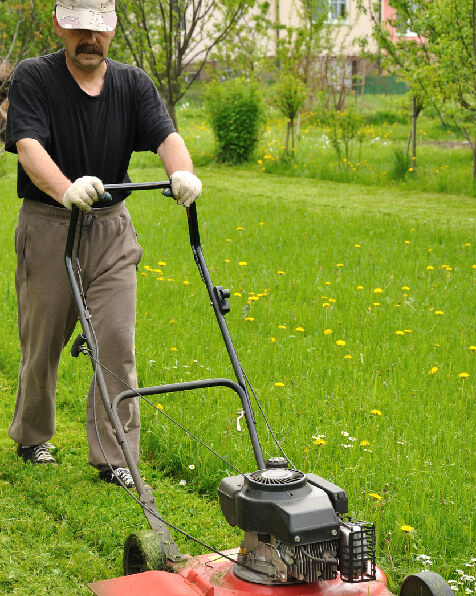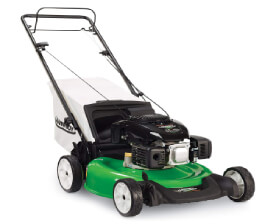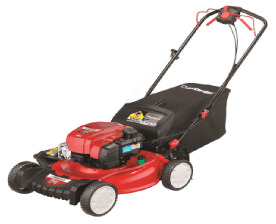Prior to getting into brands, models, and servicing recommendations it is wise to do the basic analysis around the various types of self-propelled lawn mowers that are on the market today.
Each of these types of self-propelled lawn mowers offer certain features that are standard to the product category which include:
- Adjustable height so you can change the height at which you cut your grass.
- Basic safety standards around discharging of clippings.
- A similar design with a deck that has handles coming back towards the user so they can walk behind the self-propelled lawn mower.
- Moderately low weight, with many of the heavier models still coming in below 150 pounds.
- Fairly easy storage given length and width of deck is almost always under 24 inches. The only trick is the handlebars which do stretch back further than the deck, and can create some issues unless you fold them down after usage.
- Regular maintenance that any layman can complete after reading the instructions and following them clearly.
- Minimal need for training for usage in production environments.
The types of self-propelled lawn mowers widely available today are:
- Gas with recoil start: This was the most common type of self-propelled lawn mower you would see back in the 80s, 90s, and even early 2000s, and is losing popularity today. The advantages are minimal maintenance due to standard small engines (normally Briggs & Stratton, Honda, or Tecumseh), easily sharpened blades, and standard servicing at most repair shops. Most offer versatile options of either bagging, mulching, or side discharge which helps based on the season. The main con of this type of product is the recoil start, which can be a challenge for some, particularly people with shoulder injuries.
- Gas with electric start: This type of self-propelled lawn mower was less common in the 80s, 90s, and even early 2000s, and is gaining popularity currently. The advantages are you do not need to mess with a pull-cord to start as you do with a recoil model. Similar to recoil start, they also offer little maintenance due to standard small engines (again often a Briggs & Stratton, Honda, or Tecumseh). They also easily sharpened blades, and standard servicing at most repair shops. Most also offer versatility with mulching, bagging, or side discharge chutes which help accommodate every season. The main con of this product category is the electric start, which is one more component that can malfunction and create a headache.
- Battery that charges via electricity, and is cordless in operation: This type of self-propelled lawn mower was less common in the 80s, 90s, and even early 2000s, and is very popular today for many reasons related to noise and air pollution. The advantages are you avoid the loud engine and pollution around your neighborhood. There is also no engine maintenance, these products only have an electric motor. They also easily sharpened blades, and thus low overall maintenance. Many also offer flexibility between mulching, bagging, or side discharge chutes. The main cons of this product category are you have to remember to charge it or you cannot use it, and it has a limited run-time on one charge (often less than 60 minutes with most models), which can hinder larger lawn cutting projects. Of course there are some risks and safety issues associated with having a powerful item that is charged up and accessible around your home, although this is a risk you find with other appliances as well.
- Electric corded, no cordless operation: This type of self-propelled lawn mower was less common in the 80s, 90s, and even early 2000s, and is somewhat popular today for many of the same reasons as cordless electric options. The advantages of no loud engine and air pollution around your neighborhood have some drawbacks with cord management and cord length limits which have hurt total popularity for this category. There is also no engine maintenance, these products only have an electric motor like their cordless cousins. They also offer easily sharpened blades, and thus low overall maintenance. Many also offer flexibility between mulching, bagging, or side discharge chutes. The main cons of this product category are you have to constantly watch out for the cord itself while you are mowing, which can hinder larger lawn cutting projects. You are also in need of many extension cords or changing outlets to cover your entire lawn if it is spread out. If you cut the cord (which sadly does happen), there are real safety concerns given the risk of electrocution.
Within each of these types you can normally install a bagging system to remove most grass clippings and leaves, you can use shredding and/or mulching blades, or you can discharge via side safety chute with normal blades, leaving the clippings in your yard.
Here is when each type of self-propelled lawn mower may make sense for most people:
- Gas with recoil start: You have no shoulder or lower back/walking limitations, and no noise or air pollution issues to contend with. Your total cutting time will be reduced greatly by using a self-propelled lawn mower and your time is very important to you.
- Gas with electric start: You have a shoulder or lower back/walking limitation or injury, and yet no noise or air pollution issues to contend with. Your total cutting time will be reduced greatly by using a self-propelled lawn mower and your time is very important to you.
- Battery that charges via electricity, and is cordless in operation: You have a shoulder or lower back/walking limitation or injury, and noise and/or air pollution issues to contend with. You do not like managing electric cords while you mow, or you have large distances and obstacles to maneuver around and prefer avoiding the overall hassle and risks of a corded product.
- Electric corded, no cordless operation: You have a shoulder or lower back/walking limitation or injury, and noise and/or air pollution issues to contend with. You do not mind managing electric cords while you mow, or you have only short distances/small yard spaces obstacles to maneuver around and prefer avoiding the risks of a battery powered product.






